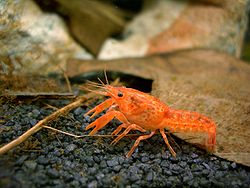| Cambarellus | |
|---|---|
 | |
| Cambarellus lesliei | |
| Scientific classification | |
| Kingdom: | Animalia |
| Phylum: | Arthropoda |
| Class: | Malacostraca |
| Order: | Decapoda |
| Suborder: | Pleocyemata |
| Family: | Cambaridae |
| Genus: | Cambarellus Ortmann, 1905 [1] |
| Type species | |
| Cambarus montezumae de Saussure, 1857 | |
Cambarellus is a genus of small freshwater crayfish in the family Cambaridae. The 19 species are found in Mexico (subgenus Cambarellus) and the Gulf States of the United States (subgenus Pandicambarus). Among the Mexican species, C. areolatus, C. patzcuarensis, and C. prolixus are considered seriously threatened by the IUCN, and C. alvarezi is already extinct. C. chihuahuae was also believed to be extinct until rediscovered in 2012. [2] C. alvarezi and four undescribed, extinct Cambarellus species were restricted to desert spring systems in southwestern Nuevo León; each one shared its habitat with a Cyprinodon pupfish (these are also fully extinct or extinct in the wild). [3] [4]
Contents
An orange form of C. patzcuarensis is regularly seen in the freshwater aquarium trade. [5]

